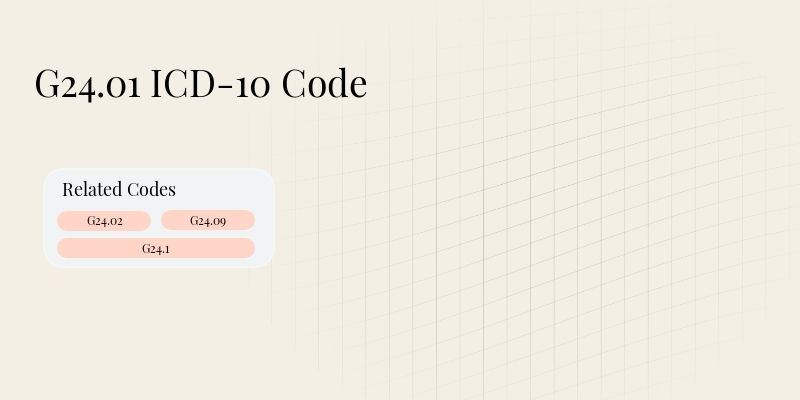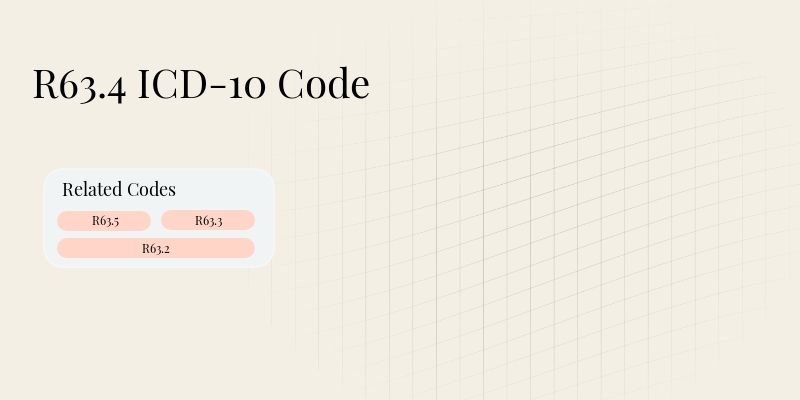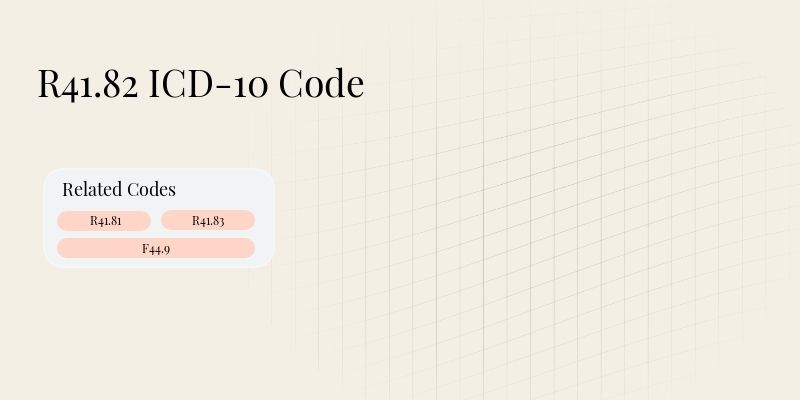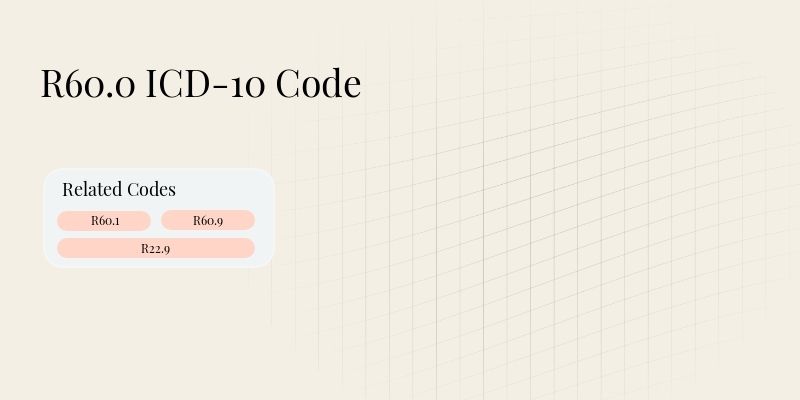
G24.01 ICD-10 Code: Tardive Dyskinesia

Key Takeaways
- What G24.01 ICD-10 Code Covers: This code specifically addresses tardive dyskinesia, a neurological disorder characterized by involuntary movements typically caused by long-term use of certain psychiatric medications. Correct coding ensures accurate patient records and appropriate treatment plans.
- Session duration requirements: Documentation should include the duration of symptoms and treatment sessions, as this is crucial for establishing the severity and management of the condition. Accurate session logs help in justifying claims.
- Who can use the code: This code can be applied by healthcare providers such as psychiatrists, neurologists, and primary care physicians who diagnose and manage patients with tardive dyskinesia. Proper coding supports appropriate reimbursement for services rendered.
- Best practice for proper use: Ensure that the documentation clearly reflects the diagnosis and any relevant clinical findings. This includes noting any prior medications that may have contributed to the condition, which aids in compliance and audit readiness.
- Example of actual usage: A patient with a history of schizophrenia develops involuntary facial movements after being treated with antipsychotic medications. The provider documents the diagnosis as tardive dyskinesia using the G24.01 code, ensuring that the claim is appropriately submitted for reimbursement.
What is G24.01 ICD-10 Code
The G24.01 ICD‑10 code specifically refers to tardive dyskinesia, which is a movement disorder often resulting from prolonged exposure to antipsychotic medications. Patients affected by this condition may exhibit uncontrollable movements of the face, tongue, and limbs, which can significantly impact their quality of life.
Understanding this code is essential for healthcare professionals as it helps ensure that patients receive appropriate treatment and that healthcare providers are accurately reimbursed for their services. Accurate coding is crucial not just for billing purposes but also for tracking the prevalence and management of tardive dyskinesia in clinical settings.
Services Covered Under G24.01 ICD-10 Code
This section outlines various services that can be billed under the G24.01 code, which are primarily focused on the diagnosis and management of tardive dyskinesia.
Service | Description | Typical Duration |
|---|---|---|
Initial Evaluation | A comprehensive assessment to diagnose tardive dyskinesia. | 60-90 minutes |
Follow-Up Visits | Regular monitoring and management of symptoms and treatment efficacy. | 30-60 minutes |
Medication Management | Adjustment of psychiatric medications to mitigate symptoms. | 30-45 minutes |
Therapeutic Interventions | Physical therapy or counseling to help manage involuntary movements. | Varies |
Who Can Use the G24.01 ICD-10 Code?
The G24.01 code can be used by a variety of healthcare providers who are involved in the diagnosis and treatment of tardive dyskinesia. These providers must understand the nuances of the condition for accurate coding.
- Psychiatrists: They play a key role in diagnosing and managing psychiatric disorders that can lead to tardive dyskinesia.
- Neurologists: Specialists in movement disorders who can offer targeted therapies for managing symptoms.
- Primary Care Physicians: They often first identify symptoms and refer patients for specialized care.
- Clinical Pharmacists: They may be involved in reviewing medication regimens and optimizing treatment plans for affected patients.
How to Use G24.01 ICD-10 Code
When coding for tardive dyskinesia, it is important to follow best practices to ensure accuracy and compliance.
- Document Clinical Findings: Always include specific details about the involuntary movements observed. For example, note if the patient exhibits facial grimacing or tongue movements.
- Include Treatment History: Record any prior medications that may have contributed to the condition. For instance, if the patient was on a long-term antipsychotic, document this in the patient's history.
- Use Supporting Codes: If applicable, use additional codes for related conditions or symptoms to provide a comprehensive view of the patient’s health status.
- Regularly Review Documentation: Ensure notes are updated after each visit to reflect the patient’s progress and any changes in treatment. For example, if a medication was adjusted, document the rationale for this change.
Reimbursement Rates for G24.01 ICD-10 Code
Insurance Type | Average Reimbursement Rate |
|---|---|
Medicare | $150 - $300 per session |
Medicaid | $100 - $250 per session |
Private Insurance | $200 - $400 per session |
Disclaimer: Reimbursement rates are subject to change based on various factors including location, provider agreements, and updates to insurance policies. It is recommended to regularly check for the most current average prices.
Benefits of G24.01 ICD-10 Code
The G24.01 code provides several benefits that enhance patient care and practice efficiency.
Benefit | Description |
|---|---|
Accurate Diagnosis | Ensures that patients with tardive dyskinesia receive the appropriate care and support they need for their condition. |
Streamlined Billing | Improves the efficiency of the billing process, leading to quicker reimbursements for services rendered. |
Enhanced Treatment Plans | Facilitates the development of tailored treatment strategies that can mitigate symptoms effectively. |
Data Collection | Contributes to the collection of data on the prevalence and treatment of tardive dyskinesia, informing future research and healthcare policies. |
Common Mistakes to Avoid with G24.01 ICD-10 Code
Improper use of the G24.01 code can result in audits and denials, leading to financial loss for healthcare providers. It is essential to be aware of common mistakes to ensure compliance and accurate billing.
- Failure to Document Symptom Onset: Not recording when the symptoms began can lead to challenges in justifying the diagnosis. For instance, a psychiatrist might miss documenting that symptoms appeared after a medication change.
- Inaccurate Coding for Medication Side Effects: Confusing tardive dyskinesia with other movement disorders can result in incorrect coding. A provider may mistakenly code for another condition if they do not clearly differentiate the symptoms.
- Neglecting Follow-Up Documentation: Failing to document follow-up visits undermines the treatment plan. For example, if a neurologist doesn’t note the patient’s progress after a medication adjustment, it can complicate future claims.
- Omitting Supporting Clinical Evidence: Not including evidence from examinations can lead to denials. A healthcare provider might assume that mentioning the diagnosis alone suffices, but supporting documentation is critical.
G24.01 ICD-10 Code vs Other Codes
Understanding how the G24.01 code compares to other related codes can clarify its specific use and importance within the coding framework.
Code | Description | Key Differences |
|---|---|---|
G24.01 | Tardive dyskinesia | Specifically targets involuntary movements due to antipsychotic medications. |
G25.2 | Other specified drug-induced movement disorders | Covers various drug-induced conditions but is not specific to tardive dyskinesia. |
F06.4 | Psychotic disorder due to another medical condition | Focuses on psychotic symptoms rather than movement disorders. |
Conclusion
The G24.01 ICD‑10 code is a crucial designation for diagnosing and treating tardive dyskinesia, a movement disorder often resultant from long‑term antipsychotic medication use. Proper understanding and application of this code allow healthcare providers to deliver appropriate patient care while ensuring accurate billing and reimbursement. Key considerations include thorough documentation of symptoms, treatment history, and session durations to avoid common errors that could lead to audits or claim denials. By adhering to best practices in coding and documentation, healthcare professionals can enhance treatment efficacy, streamline billing processes, and contribute valuable data to the ongoing understanding of tardive dyskinesia within clinical practice. Staying informed about reimbursement rates and regulations further supports the financial viability of practices managing patients with this condition.
Disclaimer: This article is for informational purposes only and does not constitute legal or medical advice. Always consult professional guidelines and regulatory bodies for specific compliance requirements.
Frequently Asked Questions
Reduce burnout,
improve patient care.
Join thousands of clinicians already using AI to become more efficient.

R63.4 ICD-10 Code: Abnormal weight loss
Discover essential insights on the R63.4 ICD-10 Code code for health professionals. Enhance your practice and navigate billing with confidence.

R41.82 ICD-10 Code: Altered mental status
Discover essential insights on the R41.82 ICD-10 Code code for health professionals. Enhance your practice and navigate billing with confidence.

R60.0 ICD-10 Code: Peripheral Edema
Discover essential insights on the R60.0 ICD-10 Code code for health professionals. Enhance your practice and navigate billing with confidence.
